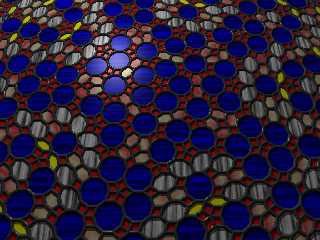|
 |
The Generalized Dual Method, or GDM, in two dimensions, is named after a
peculiar duality between:
1. An arrangement of lines in the plane.
2. A tiling by zonogons (centrally-symmetrical polygons).
The Penrose tiling of 72- and 36-degree rhombs may be obtained using the GDM,
for instance.
The "duality" arises because if two lines in the arrangement intersect, a rhomb
arises in the tiling. Every open space between lines, bounded or unbounded,
corresponds to a vertex in the tiling; and every segment or ray cut out by the
lines corresponds to an edge in the tiling.
If three lines intersect in one point, a hexagon arises; if four lines, an
octagon. And so on. These may or may not be regular.
One could pass a set of lines in general position to the GDM, no two lines
parallel; only rhombs would arise.
More typically, one explores symmetry, and makes an arrangement of lines using
"n" (an integer) subsets, each subset parallel to one of the sides of a regular
n-gon. Each subset is composed of, say, "k" (an integer) parallel lines.
Typically, they are evenly-spaced. But they need not be evenly-spaced.
Research into such tilings often restricts them to rhombic tilings; it is
ensured that no more than two lines intersect at any one point. I myself often
prefer to explore the opposite: I force as many lines as possible to intersect
at as many points as possible.
If n=5, each subset is parallel to one of the sides of a regular pentagon, then;
I begin with an arrangement of five lines, arranged so they form a kind of star
pentagon, a pentagram (but the lines extend beyond the pentagram to infinity).
I find the ten points of intersection, and I add another set of five lines, at
distances such that the initial ten points of intersection are all hit again by
my new lines. I poll this new arrangement for all its points of intersection,
and add more lines, forcing more intersections. And then, more.
When five lines intersect at one point, then, a regular decagon arises. And if
five lines intersect in many points, many decagons arise ...
Post a reply to this message
Attachments:
Download 'higher_zonogons.jpg' (132 KB)
Preview of image 'higher_zonogons.jpg'

|
 |




![]()